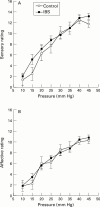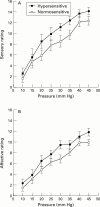Evidence for two distinct perceptual alterations in irritable bowel syndrome
- PMID: 9391250
- PMCID: PMC1891510
- DOI: 10.1136/gut.41.4.505
Evidence for two distinct perceptual alterations in irritable bowel syndrome
Abstract
Background: Visceral hyperalgesia has been implicated as a factor contributing to symptom generation in irritable bowel syndrome (IBS). However, previous studies using intestinal balloon distension have used psychophysical procedures which do not provide adequate and unbiased measures of visceral sensitivity.
Methods: Three psychophysical tasks were examined in 45 patients with IBS (positive Rome criteria) and 14 controls using rectal balloon distension with a computerised distension device. Discomfort threshold and tolerance were assessed during an ascending series of phasic pressure stimuli and during an interactive threshold tracking procedure. In addition, stimulus response functions were generated from intensity and unpleasantness ratings of the rectal distensions.
Results: Discomfort threshold and tolerance for the ascending stimuli were significantly lower for the patients with IBS compared with the controls. In contrast, discomfort thresholds during the tracking procedure and stimulus response curves for the ascending series were not different between the groups. A factor analysis of the psychophysical data was consistent with the presence of two distinct and unrelated perceptual alterations related to rectal distension: hypervigilance for visceral stimuli, manifested as lowered response criteria for using the descriptor "discomfort"; and rectal hypersensitivity, manifested as a lower discomfort threshold and left shift of the stimulus response curves.
Conclusions: Patients with IBS as a group have a greater propensity to label visceral sensations negatively and show a lower tolerance for rectal balloon distension. A subgroup of patients also have baseline rectal hypersensitivity, assessed by unbiased measures of discomfort threshold and stimulus intensity judgements.
Figures





Comment in
-
Opening the doors of perception in the irritable bowel syndrome.Gut. 1997 Oct;41(4):567-8. doi: 10.1136/gut.41.4.567. Gut. 1997. PMID: 9391262 Free PMC article. No abstract available.
References
Publication types
MeSH terms
Grants and funding
LinkOut - more resources
Full Text Sources
Other Literature Sources
Medical
